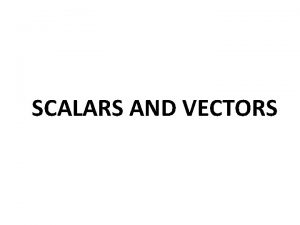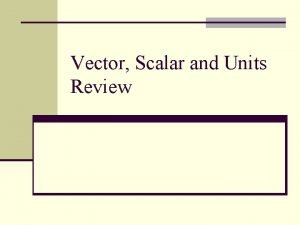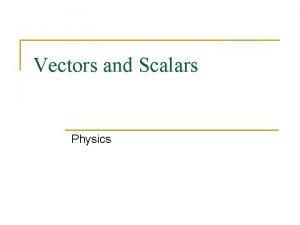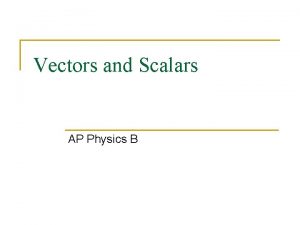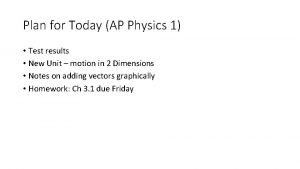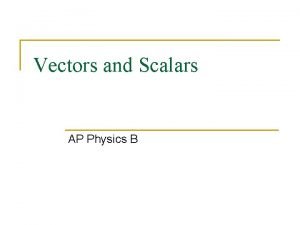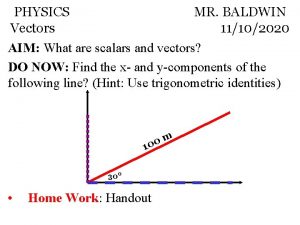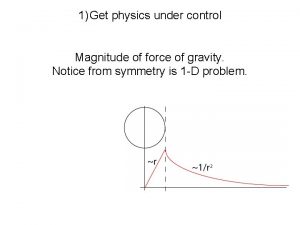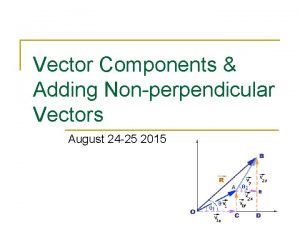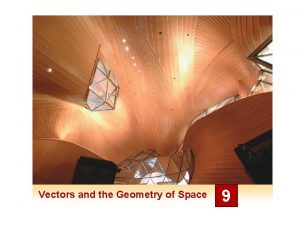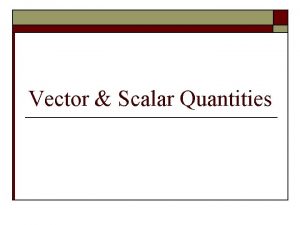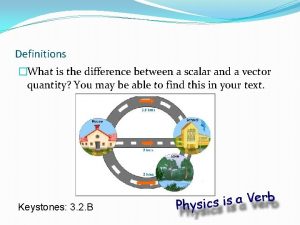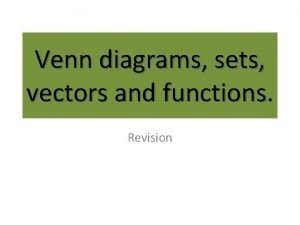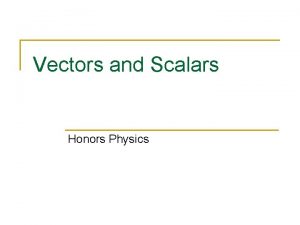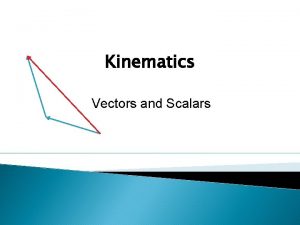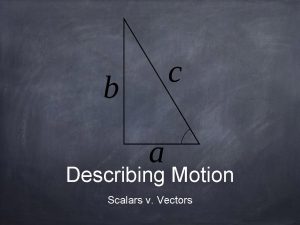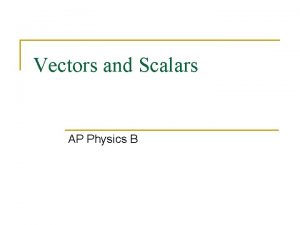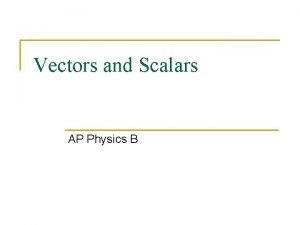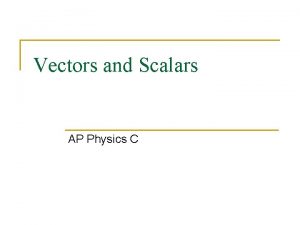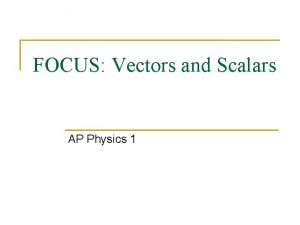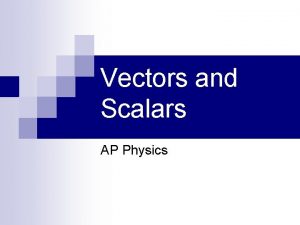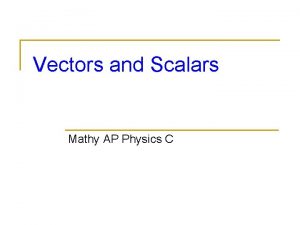Vectors and Scalars AP Physics Scalar n n






























- Slides: 30

Vectors and Scalars AP Physics

Scalar n n A SCALAR is ANY quantity in physics that has MAGNITUDE, but NOT a direction associated with it. Magnitude – A numerical value with units. Scalar Example Speed Magnitude Distance 10 m Age 15 years Heat 1000 calories 20 m/s

Vector n A VECTOR is ANY quantity in physics that has BOTH MAGNITUDE and DIRECTION. Vectors are typically illustrated by drawing an ARROW above the symbol. The arrow is used to convey direction and magnitude. Vector Magnitude & Direction Velocity 20 m/s, N Acceleration 10 m/s/s, E Force 5 N, West

y Ay Ax + A y = A A = A sin θ θ Ax = A cos θ x

Scalar Multiplication. Multiplying a vector by a scalar will ONLY CHANGE its magnitude. Multiplying a vector by “-1” does not change the magnitude, but it does reverse it's direction or in a sense, it's angle. Thus if A = 12 < 105, Then 2 A = 24 < 105 -1/2 A Thus if A = 12 < 105, then -A = 12 < 285 If A = 12 < 105, then (-1/2)A = 6 < 285

Unit Vector Notation n An effective and popular system used in engineering is called unit vector notation. It is used to denote vectors with an x-y Cartesian coordinate system.

Unit Vector Notation =3 j J = vector of magnitude “ 1” in the “y” direction i = vector of magnitude “ 1” in the “x” direction = 4 i The hypotenuse in Physics is called the RESULTANT or VECTOR SUM. The LEGS of the triangle are called the COMPONENTS 3 j 4 i Horizontal Component Vertical Component NOTE: When drawing a right triangle that conveys some type of motion, you MUST draw your components HEAD TO TOE.

Unit Vector Notation The proper terminology is to use the “hat” instead of the arrow. So we have i-hat, j-hat, and k-hat which are used to describe any type of motion in 3 D space. How would you write vectors J and K in unit vector notation?

Applications of Vectors n VECTOR ADDITION – If 2 similar vectors point in the SAME direction, add them. n Example: A man walks 54. 5 meters east, then another 30 meters east. Calculate his displacement relative to where he started? 54. 5 m, E + 84. 5 m, E 30 m, E Notice that the SIZE of the arrow conveys MAGNITUDE and the way it was drawn conveys DIRECTION.

Applications of Vectors n n VECTOR SUBTRACTION - If 2 vectors are going in opposite directions, you SUBTRACT. Example: A man walks 54. 5 meters east, then 30 meters west. Calculate his displacement relative to where he started? 54. 5 m, E 30 m, W 24. 5 m, E

Non-Collinear Vectors n When 2 vectors are perpendicular, you must use the Pythagorean theorem. A man walks 95 km, East then 55 km, north. Calculate his RESULTANT DISPLACEMENT. 55 km, N 95 km, E

What about the VALUE of the angle? ? ? n Just putting North of East on the answer is NOT specific enough for the direction. We MUST find the VALUE of the angle. To find the value of the angle we 109. 8 km 55 km, N N of E 95 km, E So the COMPLETE final answer is : use a Trig function called TANGENT.

Example 1 n A boat moves with a velocity of 15 m/s, north in a river which flows with a velocity of 8. 0 m/s, west. Calculate the boat's resultant velocity. 8. 0 m/s, W 15 m/s, N Rv q The Final Answer :

How could you add the following vectors? A = 15 m/s, o 45 N of E B = 15 m/s, 20 o N of E C = 20 m/s, o 65 N of E

GRAPHICALLY: A 450

GRAPHICALLY: A+B B 200 A

GRAPHICALLY: A+B+C C = B A 650

= Draw and Find the Components of A R Note: A = Ax + Ay A+B+C A GRAPHICALLY: Ay 450 Ax By Components: How can R be determined mathematically?

Draw and Find the Components of B Note: B = Bx + By B 200 Bx By

Draw and Find the Components of C Cy C Note: C = Cx + Cy 650 Cx

Add the x-components together Cx Bx Ax

Add the y-components together Cy By Ay

Combine all x components together to get Rx and all y components together to get Ry. Ry = Ay + By + Cy Rx = A x + B x + C x

R Ry Rx

Mathematically determine R R = Rx 2 + Ry 2 = tan -1 (Ry/Rx) R Ry Rx

So let’s do it! Solve for the sum of these velocity vectors mathematically: A = 15 m/s, o 45 N of E B = 15 m/s, 20 o N of E C = 20 m/s, o 65 N of E

What’s the correct answer? V = 47. 40 m/s, 45. 6 N of E


Example 2 n A bear, searching for food wanders 35 meters east then 20 meters north. Frustrated, he wanders another 12 meters west then 6 meters south. Calculate the bear's displacement. - 12 m, W - = 6 m, S 20 m, N 35 m, E 14 m, N R q 23 m, E The Final Answer: = 14 m, N 23 m, E

What if you are missing a component? n Suppose a person walked 65 m, 25 degrees East of North. What were his horizontal and vertical components? The goal: ALWAYS MAKE A RIGHT TRIANGLE! H. C. = ? V. C = ? 25 65 m To solve for components, we often use the trig functions sine and cosine.
 A storm system moves 5000 km due east
A storm system moves 5000 km due east Difference between vectors and scalars
Difference between vectors and scalars Vector quantity and scalar quantity
Vector quantity and scalar quantity Scalars and vectors
Scalars and vectors Lesson plan on vectors and scalars
Lesson plan on vectors and scalars Multiplying or dividing vectors by scalars results in
Multiplying or dividing vectors by scalars results in Magnetic field intensity is scalar or vector
Magnetic field intensity is scalar or vector Scalar product of vectors
Scalar product of vectors Prasanna balaprakash
Prasanna balaprakash Scalar physics
Scalar physics A storm system moves 5000 km due east
A storm system moves 5000 km due east Ap physics vectors test
Ap physics vectors test Ap physics vectors
Ap physics vectors Tip to tail method
Tip to tail method Physics vectors
Physics vectors Components of vector
Components of vector Color vectors and viewpoint in still and moving images
Color vectors and viewpoint in still and moving images Modern physics vs classical physics
Modern physics vs classical physics University physics with modern physics fifteenth edition
University physics with modern physics fifteenth edition Good physics ia topics
Good physics ia topics Vector quantity
Vector quantity Scalar projection vs vector projection
Scalar projection vs vector projection Scalar distance
Scalar distance Find the scalar and vector projections of b onto a.
Find the scalar and vector projections of b onto a. Dot product
Dot product Characteristics of vector quantity
Characteristics of vector quantity Scalar and vector quantity difference
Scalar and vector quantity difference Scalar quantity and vector quantity
Scalar quantity and vector quantity Scalar and vector quantization
Scalar and vector quantization Venn diagram of a union b
Venn diagram of a union b Scalar multiplication matrix
Scalar multiplication matrix



